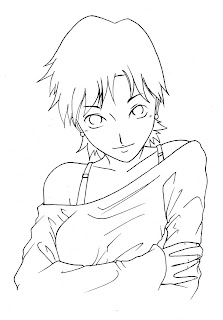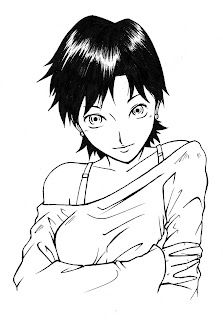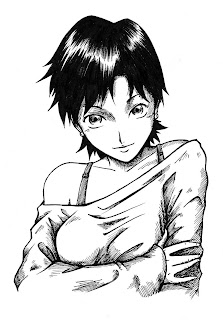So what is the biggest problem in inking manga? Yea, I know, "my hand's shaking... I can't draw a smooth straight line!"
My advise to handle this problem:
~ change the way you do your inking - sometimes drawing long, smooth line just isn't for you, so change the way you ink your manga, I'll get into this later.
~ relax and concentrate - don't hold your pen too tight, just relax and focus on your drawing.
~ KEEP PRACTICING! - practice makes perfect, but no one's perfect, so why practice? But let's put it like this - if you DON'T practice, you'll get NO WHERE near to be even good. So if you want to make something GOOD out of yourself - KEEP PRACTICING!
Inking Styles:
 This is for full colour illustration and heavy screentone manga. Thin, fine lines are used for the inking, and it is drawn evenly throughout the entire picture without putting any stress on any portion of the picture.
This is for full colour illustration and heavy screentone manga. Thin, fine lines are used for the inking, and it is drawn evenly throughout the entire picture without putting any stress on any portion of the picture.This is to allow clear, clean space for colouring and screentone purpose.
 If you had noticed the difference with the previous style already, this picture were illustrated with different weight of strokes throughout the entire artwork. The heavy strokes were used to represent the shadow of the area, hence it gives your artwork more sense of volume and dimension.
If you had noticed the difference with the previous style already, this picture were illustrated with different weight of strokes throughout the entire artwork. The heavy strokes were used to represent the shadow of the area, hence it gives your artwork more sense of volume and dimension.This inking style prepares the artwork for heavy screentoning, one of the mangaka that uses this style for heavy screentone was Fujisawa Tooru sensei, the creator of Great Teacher Onizuka.
Otherwise, it is used for hatching purposes.
 The third style introduced here utilizing only pen techniques for toning, it's known as hatching or cross-hatching where the mangaka uses different weight and style of strokes, crossing them together to represent the tones of the artwork. First, the artwork is prepared with the second style as mentioned above, then cross-hatching the darker area for tones. Or you can just cross-hatch everything from the beginning, it still produces the same thing if not more artistic manga!
The third style introduced here utilizing only pen techniques for toning, it's known as hatching or cross-hatching where the mangaka uses different weight and style of strokes, crossing them together to represent the tones of the artwork. First, the artwork is prepared with the second style as mentioned above, then cross-hatching the darker area for tones. Or you can just cross-hatch everything from the beginning, it still produces the same thing if not more artistic manga!For references, try Vagabond, a manga by Inoue Takehiko sensei, who's also the creater of Slam Dunk.


Well hello there! In your article did you use the data from any extra studies or here are totally your own conclusions? Thank you so much in advance for your reply.
ReplyDeleteSolely my own exoerience, which I gathered from trial & error as well as researches & studies.
Deletecan you just use regular. white blank paper?
ReplyDeleteThat'll depends what you use to draw.
DeleteFor instance, if you are using G-pen or brush and ink, then you'll really need a thicker and probably bigger piece of paper to draw on.
is it important to ink the manga?
ReplyDeletei mean can i just use the pencil
Well if u don't ink your work, chances are the printer can't print it out, or u can always pay more to get it print~
Delete